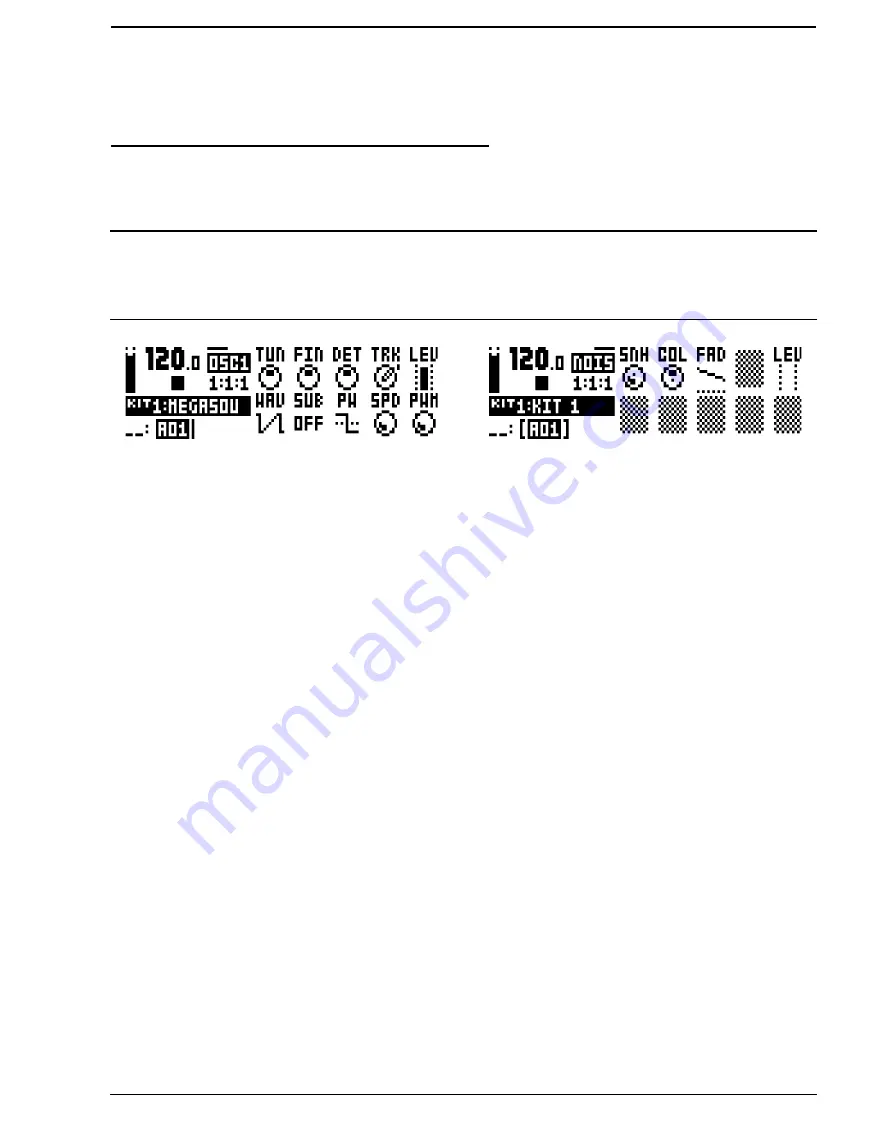
Appendix A: SYNTH TRACK PARAMETERS
A-1
Appendix A: SYNTH TRACK PARAMETERS
In this appendix, the parameters of the synth tracks are explained.
OSC 1 (page 1)
TUN
(OSC1 Coarse Tune) sets the pitch of the oscillator in semi-
tones. To jump a whole octave, press the knob while turning it.
FIN
(OSC1 Fine Tune) fine tunes the pitch of the oscillator. This
knob can be continuously tweaked several turns.
TUN
is
increased or decreased one semitone for every turn on
FIN
.
DET
(OSC1 Linear Detune) offsets the frequency of the oscillator
by a certain number of hertz (unlike
FIN
, which adjusts the pitch
in cents). This unique feature gives more detune in the bass
notes, and allows for a different kind of chorus-like detune that
reminds of very old and big analog synthesizers.
TRK
(OSC1 Keytrack) sets the oscillator pitch to follow the notes
you play or not. When off, the pitch is constant, which can be
convenient for drum or effects sounds.
LEV
(OSC1 Level) sets the oscillator level. Normal level is 100.
The sound can get dirtier at higher levels; lower levels gives a
cleaner signal through the filters and also makes filter reso-
nances more pronounced. Try different levels for different kinds
of sounds.
WAV
(OSC1 Waveform) sets the oscillator waveform to Saw-
tooth, Transistor Pulse, Pulse, or Triangle. It is also possible to
choose one of the two External Inputs (to send external sounds
through the filters) or to activate Filter Feedback. Note that
selecting a waveform does not change the
PW
parameter, which
affects the waveshape of the chosen waveform.
SUB
(OSC1 Sub Oscillator) sets the waveform of the sub oscilla-
tor, or turns it off. The sub oscillator pitch is fixed at one or two
octaves below the oscillator.
PW
(OSC1 Pulsewidth) sets the oscillator waveshape. The mid
position (64) gives the default waveshape. Unlike on most
synths, all four waveforms, selected by
WAV
, have variable
waveshapes.
SPD
(OSC1 PWM Speed) sets the speed of the oscillator's
PWM
LFO, which can be used to modulate the waveshape back and
forth around the set
PW
parameter.
PWM
(OSC1 PWM Depth) sets the amount of the oscillator's
Pulsewidth Modulation around the set
PW
parameter. Use this to
add subtle or drastic motion to the sound.
NOISE (page 2)
S&H
(Sample & Hold) sets the tuning of the noise spectrum.
COL
(Color) sets a filter that changes the frequency content of
the noise oscillator. Negative values render lowpass-filtered
noise. For example, a setting of -64 is red (-6dB/oct) and -32 is
pink (-3dB/oct) noise. Positive values render highpass-filtered
noise. A setting of zero disables the filter, making the output
white noise.
FAD
(Noise Fade) sets the fade-in or fade-out of the noise. The
mid position (0) gives a constant noise output. Positive values
give a fade-out, negative values give a fade-in. The graphics will
illustrate the slope of the fade, across the spectrum, as you
tweak the encoder.
LEV
(Noise Level) sets the level of noise.
OSCILLATOR 1
The OSC1 pages control the first oscillator, its suboscillator, plus the noise generator.
Summary of Contents for Analog Four
Page 1: ......
Page 4: ......
Page 11: ...ANALOG KEYS BACKGROUND 3 ...
Page 90: ...CREDITS AND CONTACT INFORMATION 82 ...
Page 102: ...B 6 Appendix B FX TRACK PARAMETERS ...
Page 122: ...D 14 Appendix D MIDI ...
Page 124: ...E 2 Appendix E ANALOG KEYS ARCHITECTURE ...
Page 128: ...4 INDEX ...
Page 129: ......
Page 130: ......








































